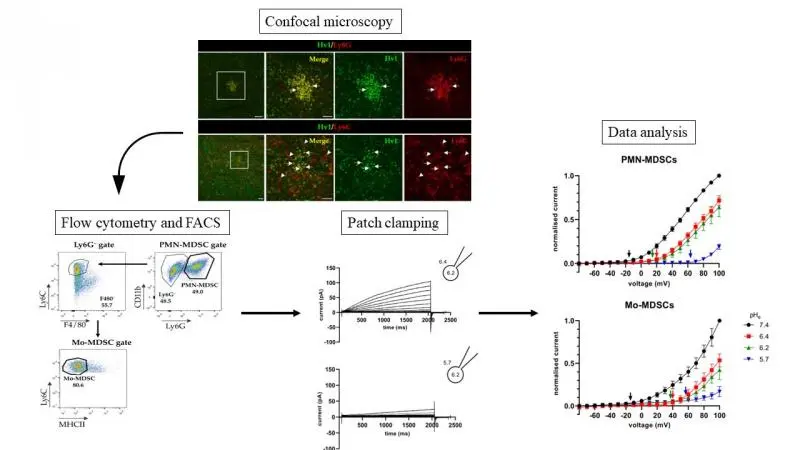
When a tumor develops in our body, our immune system recognizes it as a foreign element and starts attacking it mostly via CD4 and CD8 T lymphocytes and NK cells. Unfortunately, tumor is resilient and is able to receive help by different cell types that normally would have a completely different role, like regulatory T cells and myeloid-derived suppressor cells (MDSCs). Almost all cells in our body, including immune cells, rely on ion channels to survive and thrive, but MDSCs have never been thoroughly analyzed in this regard. With the collaboration of the Immunology Department, we subcutaneously injected Lewis Lung Cancer cells in mice in order to obtain tumor-derived MDSCs. We analyzed the tumor sections by confocal fluorescent microscopy. Furthermore, we disrupted enzymatically and mechanically the tumors and using fluorescent-activated cell sorting we obtained the tumor associated pure MDSCs. MDSCs were quickly subjected to patch-clamping, a technique that allows to analyze their plasma membrane ion channels. Through biophysical and pharmacological methods, we discovered that tumor-derived MDSCs do not present voltage-gated K+ or Na+ currents, but present evident H+ currents. We confirmed the presence of Hv1 proton channel in tumor associated MDSCs at gene and protein level through RT-qPCR and western blotting. MDSCs exert immunosuppression mainly through ROS, whose production is usually coupled to the proton channel Hv1. The presence of Hv1 in MDSCs could be in future exploited to suppress these cells in order to shape a more benign tumor microenvironment.
Authors: Marco Cozzolino, Adrienn Gyöngyösi, Eva Korpos, Peter Gogolak, Muhammad Umair Naseem, Judit Kállai, Arpad Lanyi, Gyorgy Panyi
Int. J. Mol. Sci. 2023, 24(7), 6216